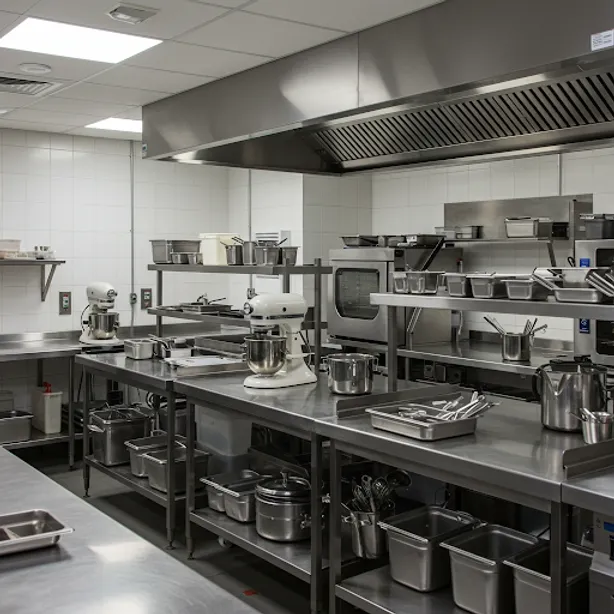
The Top Challenges Food Entrepreneurs Face & How to Overcome Them
Starting a food business is exciting, but it comes with unique challenges that can make or break your success. From high startup costs to regulatory hurdles, food entrepreneurs face a steep learning curve. But with the right strategies, you can overcome these obstacles and build a thriving business.
Here are the top challenges food entrepreneurs face—plus smart solutions to help you navigate them.
1. High Startup Costs 💰
The Challenge:
Launching a food business requires expensive equipment, permits, ingredients, and marketing. A traditional restaurant or commercial kitchen setup can cost $100,000+, making it hard for small business owners to get started.
How to Overcome It:
✅ Start in a shared kitchen – A shared commercial kitchen like La Chow provides fully equipped, health department-approved space without the huge upfront investment.
✅ Use a ghost kitchen model – Skip the cost of a storefront and focus on delivery or pop-ups.
✅ Bootstrap your business – Start with a small menu and reinvest profits to scale gradually.
2. Finding the Right Kitchen Space 🏠
The Challenge:
Food entrepreneurs need a licensed and fully equipped space to cook legally, but commercial kitchens are expensive and require long-term leases.
How to Overcome It:
✅ Rent a shared kitchen – Pay only for the time you need, without long-term commitments.
✅ Use commissary kitchens – Some facilities offer part-time rental for catering and meal prep businesses.
✅ Partner with existing restaurants – Some restaurants rent their kitchens during off-hours.
💡 La Chow Shared Kitchen gives food entrepreneurs an affordable, professional space to cook!
3. Navigating Health & Safety Regulations 🏥
The Challenge:
The food industry has strict health codes, permits, and safety requirements that vary by location. Violations can lead to fines or shutdowns.
How to Overcome It:
✅ Use a shared kitchen – Many shared kitchens (like La Chow) are already health department-approved.
✅ Take a food safety course – Stay compliant with ServSafe or other certifications.
✅ Stay up to date – Follow your local health department for regulation changes.
A chef expertly prepares fresh vegetables, demonstrating safe food handling practices by wearing gloves in a professional kitchen setting.
4. Standing Out in a Crowded Market 🍔
The Challenge:
With thousands of restaurants, food trucks, and delivery brands, how do you make your business unique?
How to Overcome It:
✅ Define your niche – Focus on a specific cuisine, dietary need, or unique experience (e.g., vegan comfort food, fusion dishes, or themed dining experiences).
✅ Create a strong brand – A memorable name, logo, and story help customers connect with your business.
✅ Use social media marketing – Show behind-the-scenes content, customer reviews, and promotions to engage your audience.
💡 Authenticity and storytelling help build customer loyalty!
An innovative food entrepreneur eagerly presents a colorful dish, emphasizing fresh ingredients and culinary passion in a chic kitchen.
5. Managing Food Costs & Profit Margins 📊
The Challenge:
Rising ingredient costs, food waste, and inefficient pricing can quickly eat into profits.
How to Overcome It:
✅ Buy in bulk – Work with wholesale suppliers or shared kitchens to get better deals.
✅ Reduce food waste – Plan portion sizes carefully and repurpose ingredients for multiple dishes.
✅ Calculate food costs – Price menu items based on ingredient costs, labor, and overhead to ensure profitability.
6. Marketing & Customer Acquisition 📣
The Challenge:
Many food entrepreneurs struggle to attract customers, especially in the early stages.
How to Overcome It:
✅ Leverage online ordering platforms – Use apps like UberEats, DoorDash, or ChowNow to reach more customers.
✅ Run social media ads – Target local foodies with Facebook and Instagram promotions.
✅ Encourage reviews & referrals – Happy customers bring in new business, so ask for Google and Yelp reviews.
💡 Consistency is key—keep engaging with your audience to build brand awareness!
7. Scaling & Expanding 🚀
The Challenge:
Once you’ve found success, scaling up can be tricky. Expanding too fast or without proper planning can lead to financial strain and quality issues.
How to Overcome It:
✅ Test your concept first – Use a shared kitchen or ghost kitchen before committing to a full-scale restaurant.
✅ Document your processes – Standardized recipes and training manuals make scaling smoother.
✅ Explore partnerships – Work with local grocery stores, catering services, or meal delivery businesses.
Final Thoughts: Overcome Challenges & Succeed in the Food Industry
Starting a food business isn’t easy, but with the right strategy, you can overcome common obstacles and thrive.
💡 Key Takeaways:
✔️ Start small & minimize costs with a shared kitchen
✔️ Stay compliant with health & safety regulations
✔️ Stand out with strong branding & marketing
✔️ Manage costs wisely to maximize profits
✔️ Test & scale strategically before expanding
At La Chow Shared Kitchen, we help food entrepreneurs turn ideas into reality—without the financial burden of opening a full kitchen.


